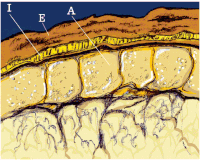
Photo from wikipedia
ABSTRACT We have investigated molecular-scale changes in soil organic matter (SOM) as incorporated wheat and corn residues decompose and whether those changes are correlated with soil nitrogen forms. The ‘initial… Click to show full abstract
ABSTRACT We have investigated molecular-scale changes in soil organic matter (SOM) as incorporated wheat and corn residues decompose and whether those changes are correlated with soil nitrogen forms. The ‘initial litter quality hypothesis’ that compositional variations in plant residues may persist during decomposition of these residues as they are transformed to SOM was tested. We studied soils in 6-year field experiments of a double-cropped corn–wheat rotation system designed with the following treatments: no crop residue and no chemical fertilizer, chemical fertilizer alone, wheat straw + chemical fertilizer, corn stover + chemical fertilizer, and corn plus wheat residue + chemical fertilizer. Organic carbon and nitrogen forms were assessed, and SOM chemical structures were examined by Fourier transform infrared and solid-state nuclear magnetic resonance spectroscopy. We found that concentrations of organic-N in corn residues plus fertilizer treatment were significantly larger than those in wheat straw plus fertilizer treatment. In addition, concentrations of amide groups and NCH in SOM with corn residue treatment were larger than those in SOM with wheat residue treatment. Incorporation of both corn and wheat residues led to an increase in carbohydrate-derived components of SOM. Compared with the check treatment, aromaticity, alkyl C/O-alkyl C, and hydrophobicity/hydrophilicity indices of the SOM were lower with addition of residue. Aromaticity was greater in corn residue treatment than in wheat residue treatment. This study provides support for the hypothesis that the variation in chemical composition of SOM reflected the incorporation of distinct chemical structures in wheat and corn straw residues.
Journal Title: Soil Science and Plant Nutrition
Year Published: 2017
Link to full text (if available)
Share on Social Media: Sign Up to like & get
recommendations!